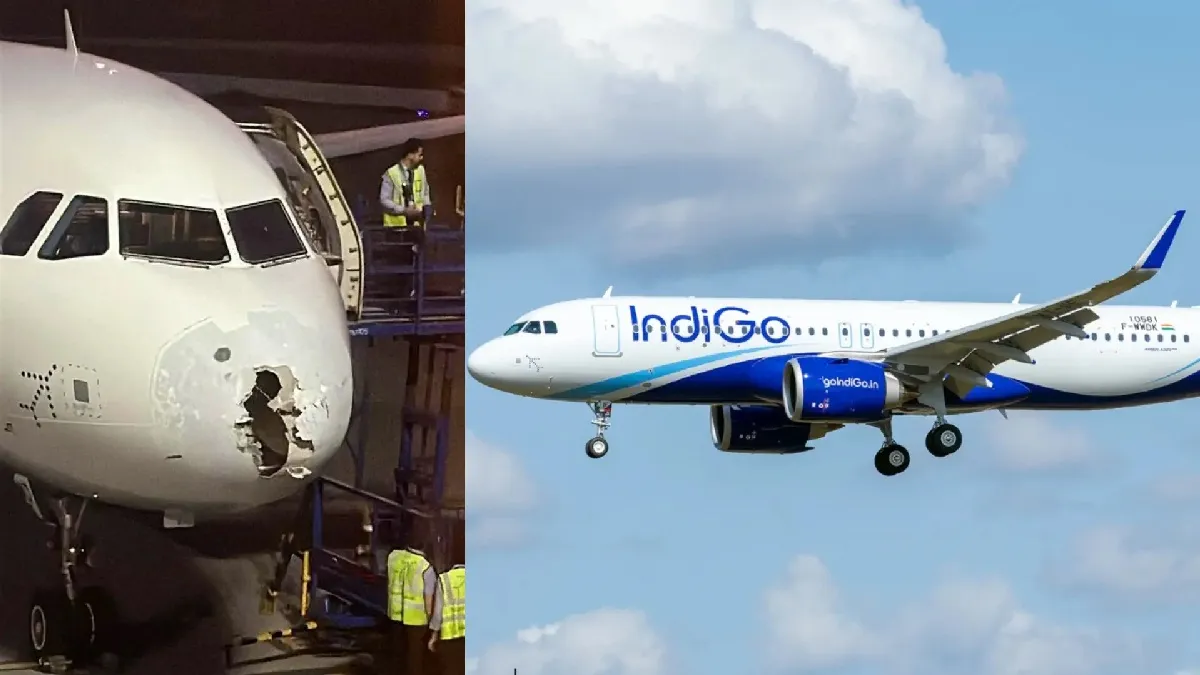When extreme weather strikes during flight times, flying crews show off their training and experience. One of the latest examples was an IndiGo flight that struggled through severe weather conditions to land in Srinagar airport. The plane went through intense turbulence and activity of a hailstorm that left visible scarring on its nose section.
What Occurred Aboard the Flight
The commercial airliner was on a routine domestic flight when it encountered an unexpected severe weather system. Pilots reported encountering extreme turbulence with intense hail intensity on their approach phase. Weather deteriorated quickly, resulting in dangerous flying conditions that tested crew expertise to its limit.
Based on the aviation authorities, the aircraft’s radome was visibly damaged from hailstone impact while enduring the encounter with the storm. Despite all these difficult conditions, the flight crew was in full control of their aircraft throughout the entire incident.
Crew Reaction and Safety Procedures
Skilled pilots are well-trained for such weather emergencies. IndiGo’s crew used standard procedure in the event of severe atmospheric turbulence. They reacted in time and used the right procedures to ensure passenger safety was always the only priority.
Some of the important safety measures taken were:
- Immediate update with air traffic control about weather
- Flight path alteration so as not to expose themselves to extreme weather conditions any longer
- Routine inspection and monitoring of aircraft systems and stability
- Planning for emergency landing procedures if needed
Expert response by the crew accounts for why commercial aviation has such excellent safety records worldwide.
Aircraft Damage Assessment
After safe landing at Srinagar airport, ground personnel thoroughly inspected the damaged plane. The radome, containing weather radar equipment, evidenced obvious impact damage from hailstones. The protective covering allows pilots to identify weather systems in front of them under normal flight conditions.
The aviation maintenance crew immediately started evaluating the extent of structural damage inflicted by the torrential hailstorm. The initial reports indicate the damage was mainly cosmetic, although full engineering assessments would decide on the last time required for repairs.
The aircraft was right away removed from service awaiting thorough safety inspections and repairs.
Understanding Weather-Related Aviation Challenges
Hailstorms present major threats to airplanes during flight operations, especially at the takeoff and landing stages. Such frozen balls of precipitation range from small pellets to golf-ball-sized ice chunks. At high speeds, even tiny hailstones can inflict major structural damage when aircraft are exposed to these weather conditions.
Advanced airplane design includes safety equipment that is designed to protect against weather-induced damage:
- Reinforced construction of the radome to resist impact forces
- Advanced storm detection weather radar systems
- Redundant flight control systems for safety during continued operation
- Extensive pilot training for surviving severe weather events
IndiGo Flight: Airport Safety and Operations Procedures
Srinagar airport, as with all large commercial airports, has very strict safety procedures in place for weather-related accidents. Ground staff reacted very quickly when the damaged aircraft indicated its status during final approach procedures.
Airport emergency services were kept on standby during the entire landing process to provide instant response capabilities in case extra help was required. This synergy between flight crews, air traffic control, and ground support teams is the best example of aviation safety culture.
Passenger Experience and Safety
In spite of the dramatic circumstances of severe weather encounters, passengers on the aircraft were safe during the entire trip. Contemporary commercial aircraft are capable of enduring extreme weather-related stresses while retaining their structural integrity.
Flight attendants would have probably prepared the passengers for possible turbulence through regular safety announcements and protocols. These highly trained staff are well aware of handling passenger anxiety in the case of unexpected flight conditions.
All the passengers were evacuated safely upon arrival, with no reported injuries from the weather encounter.
IndiGo Flight: Industry Response and Investigation
Aviation officials will perform extensive examinations of this weather-caused accident to determine any lessons that can be learned. These audits aid in enhancing future safety measures and pilot training programs within the entire industry.
IndiGo airlines issued notices affirming their devotion to passenger security and adequate maintenance practices. The airline clarified that all necessary inspections would be performed prior to returning the planes to active use.
IndiGo Flight: Weather Patterns and Flight Safety
The accident underscores persistent challenges which weather conditions present to business jet operation. Global warming could make the occurrence of extreme weather phenomena more frequent and stronger, necessitating ongoing flexibility in flight operations and airplane design.
Pilots are thoroughly trained in the recognition and avoidance of weather. Yet, occasionally sudden changes in weather leave encounters unavoidable, putting crew skills and aircraft performance to the ultimate test.
Moving Forward
This effective emergency response proves the proficiency of existing aviation safety systems and training programs. Although the aircraft sustained damage, the main goal of passenger safety was realized through competent crew performance.
The aviation industry keeps investing in sophisticated weather detection technology and better training procedures. These continuous enhancements enable future weather encounters to have equally favorable results.








Be First to Comment